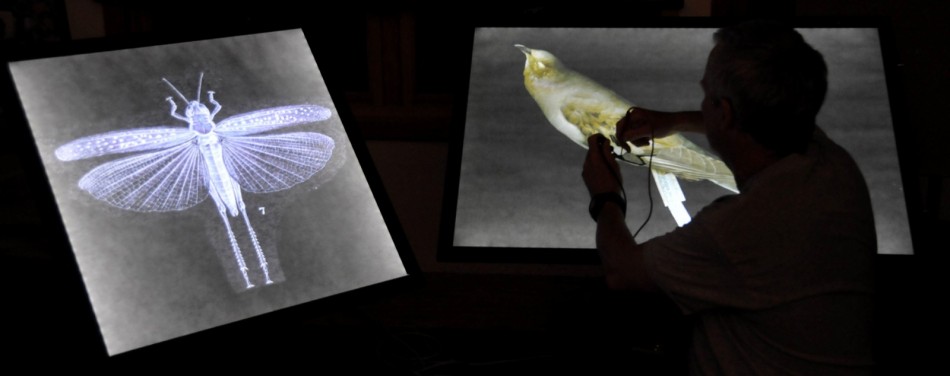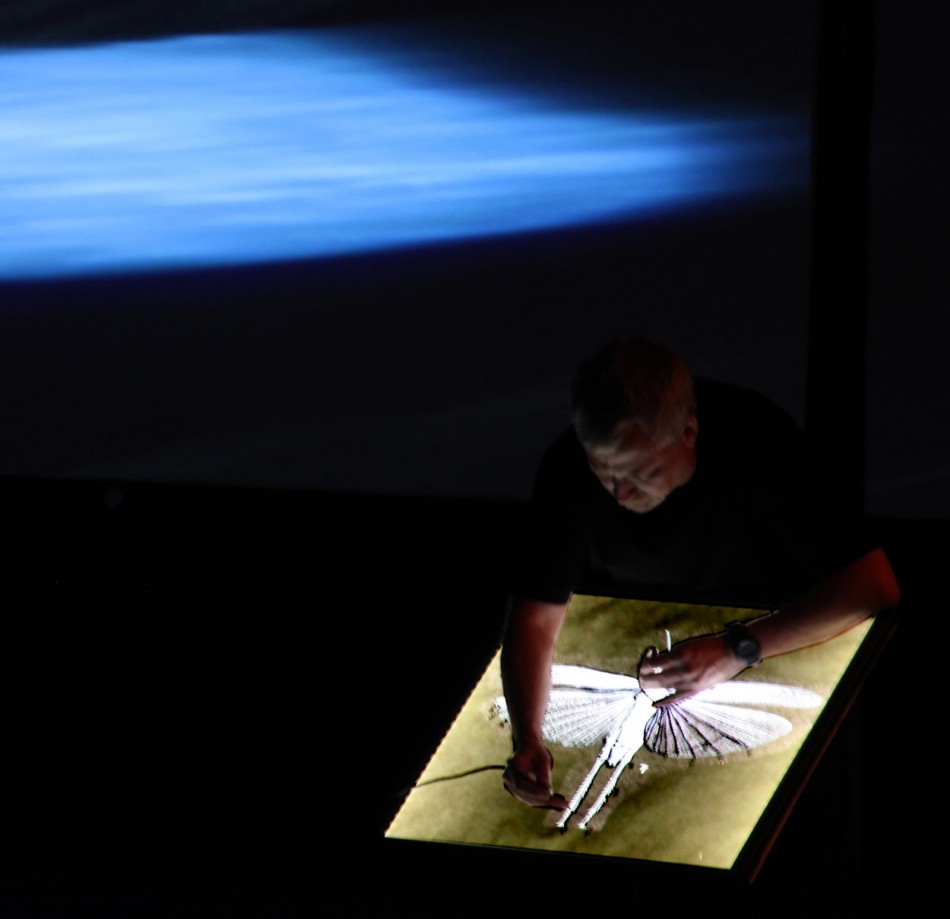
Artist-Technologist Re-Animates Extinct Species
“New media” is actually middle-aged. It’s been half a century since The Kitchen’s debut in New York; Mark Tribe founded Rhizome dot org in 1996. Kitchen co-founders Woody Vasulka and Steina, residing in Santa Fe since the ‘80s, still create, and they host a massive online archive. Currents is an annual festival of international new media art occurring, for the last six years, at El Museo Cultural and other Santa Fe sites every June. The Digital Dome at the Institute of American Indian Arts conceived a projection architecture for “digitally enabled” native storytellers. University of Denver has one of the most progressive programs in emergent digital technology in the country, alongside SUNY Buffalo, Carnegie Mellon and the School of the Art Institute of Chicago.
One of the perplexing things about “new” media in 2013 is that while it still utilizes the adjectives “new” and “emergent,” it’s largely displayed on now-traditional robust technologies such as digital projection and stable video-gaming networks.
W3fi (wee-fy) a work by Chris Coleman and Laleh Mehran, seen at Currents this year, is a purported interactive experience around the so-called “second self,” or digital “S3lf”—the information-enveloped double to our walking, physical selves. The W3fi travels and hence exists both in live and virtual space. The artists contend it explores the “sum of all the digital S3lfs” and depends upon the concept that every action has a consequence. Yet the data-informed “live mapping” it engages in include tweets, statistics and past visitor information from W3fi’s prior loci. While the patterns of LED lighting that illuminate when data is exchanged in “real-time” are visually pleasing, does it connect that all those little lights are someone else somewhere whose data-identity is active? Or is it the idea that the collective as it re-forms and joins virtual and live audiences, is creating a new social structure?
Timothy Weaver, who directs DU’s Emergent Digital Practices program as an associate professor, says “The whole notion of emergence in digital media takes into account a complexity of how things fold together in a creative situation where you can’t hardwire the outcome to it.”
Weaver utilizes his background in microbiology and environmental engineering. He collaborates with scientists at the Santa Fe Institute on “novel interactions in computational ecology.” He says his art is about creating new sensoria through which complex data can be encountered — not as pure “representations” of algorithms, per se.
Weaver focuses on extinct species through his art, he says, in an attempt to give them a second, digital life.
“They drove the cosmology of our space and they’ve gone missing,” he says. “When we think about the notion of the space, would we see these things or would we hear them? In the Amazon, you usually hear things before you see them, so what I am doing is laying in the immersion.”
At the Currents festival Weaver’s performance piece “ArthropodaChordataConiferophyta” was about the sequences around the now extinct passenger pigeon’s bio-energetic system. Utilizing data from the proteins he created an auditory and visual experience that allowed the audience to hear and be immersed in something that no longer exists.
“When you are reanimating extinction residue, we have data and most people don’t know what is meaningful in the code and I have to translate it and allow for the dialogue, then the audience has to come in and begin to rethink it.”

Timothy Weaver auralizing extinct species at Currents 2013
The DU program attempts to focus in a cross-disciplinary way on the impact of digital technology on theology, commerce, human rights and more. Art seems to be a tool in the toolbox along with design, smart networks and the open-source movement.
Weaver specifies that science threads through the program, in a way similar to Stanford’s D School. “It’s not just an art program, its much more trans-disciplinary than it’s ever been. …Our instructors with studio arts backgrounds realize there is this constant war between traditional arts and new media.” Weaver says, “In this wrestling match we are often told that ‘you guys don’t make art’ and we are fine with that.”
As Weaver points out, uses of technology are beneficent and malevolent. The same technology used in so-called emergent art projects can smarten a killer drone or let an artist create music based, as Weaver’s is, on the species’ extinction crisis.
If emergent digital arts can still seem a combo of gee-whiz and mundane, then one of the biggest conundrums ultimately goes to display—a key formal partner to technologically-aided creation. When Steina had a career retrospective at SITE Santa Fe, “the style of low-end installation that (she) pioneered… is long gone,” wrote Ellen Berkovitch in Artforum . A 21-monitor LCD flat-screen ziggurat conferred sumptuous material qualities on the imagery of The West, while historically her display protocols had been banks of analog-signal TVs and military-industrial gadgets.
This technologically advanced world doesn’t always translate into art qualities that now no longer have to only overshadow the display but to overcome the esoteric technology.
There are exceptions: Peter Sarkisian, Bill Viola, Laleh Mehran’s “Men of God, Men of Nature.” Brazilian artist César Meneghetti,’s I/O at Currents 2013 (also shown at the Kenya Pavilion of the 55th Venice Biennale this year) was four years in the making. A documentary cast of disabled members of Rome’s Community of Sant’Egidio who had made art at Italian state hospitals before they were closed in the ‘70s spoke to questions of god, existence and other humanitarian themes in compelling ways. So here is new media art that like many of Viola’s works, is technological, yet profoundly humanistic.
One can indeed create music from proteins, but do extinct animals sound like Beethoven? (Beethoven’s Ninth Symphony has an app, incidentally, that took six figures to make.)
It remains to be seen whether much emergent digital work that aims to graft art, science and technology will continue to be shown in museums, endowed by the imprimatur of art theory — or whether the points of encounter will change, too, leaving the humanistic elements behind. If so, will it still be art?
Previous coverage of new media art on AdobeAirstream is here:
Gamer Rick Silva Talks Stan Brakhage
ISEA 2012: Rocket Scientists on Big Data
